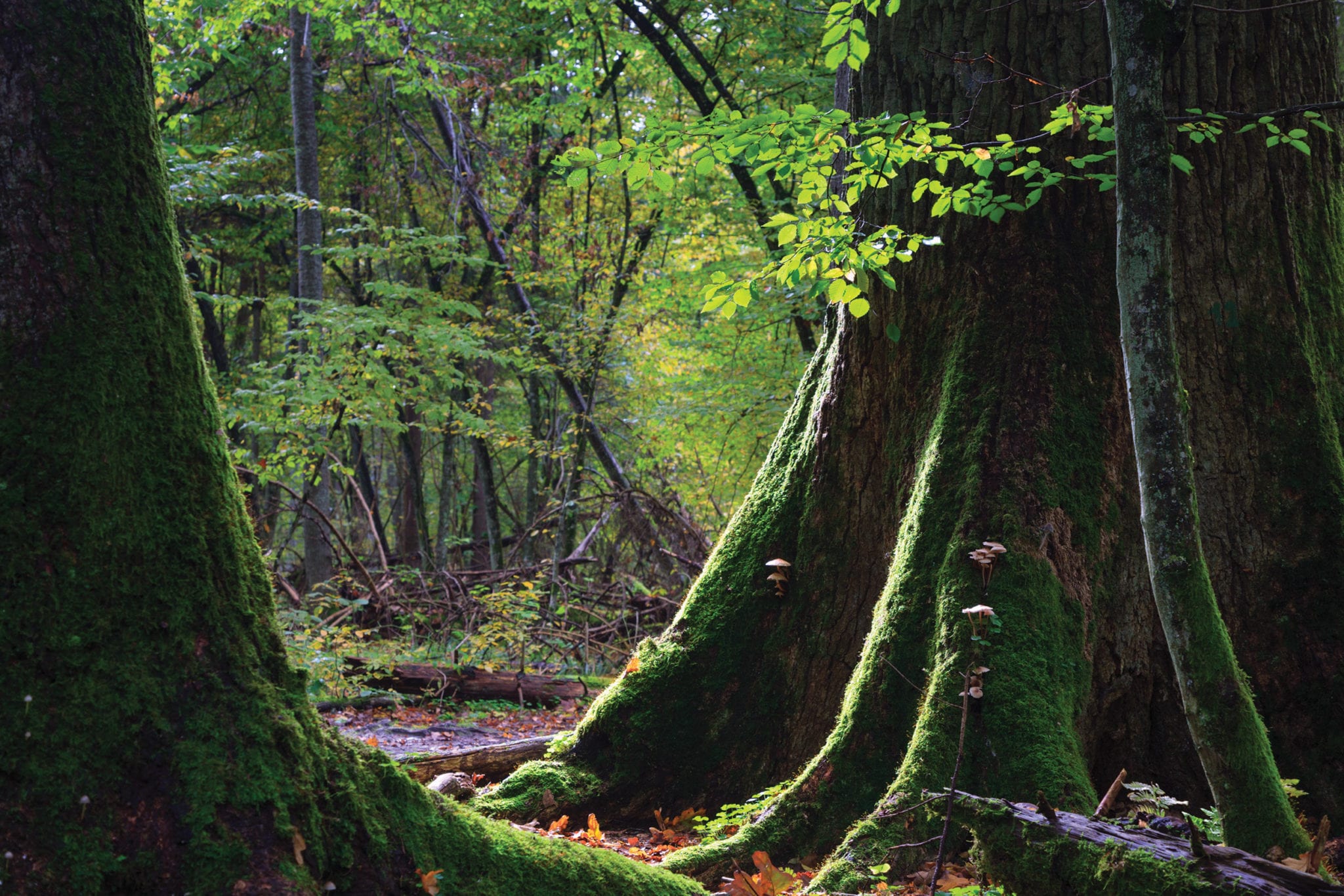Under Threat: Europe’s Old-Growth Forests

On 21 March people worldwide celebrate the UN International Day of Forests (#IntForestDay). Forests are essential for life on Earth: they are the largest stores of carbon after oceans and provide habitat for 80% of the world’s terrestrial biodiversity. But some of the most precious forests in Europe are under threat. Despite the continuous increase of forest land in Europe, biodiversity is not thriving, with many forest habitats being threatened by unsustainable forest management practices and forest fragmentation. Even illegal logging, which is most often witnessed in the context of tropical rainforests, is also happening in Europe – spotlight on Poland and Bulgaria.
We often forget that virgin forests are still present in Europe. These are untouched, centuries-old ecosystems unaffected by human developments. WWF has been campaigning to save two of these last pristine places, which are now under threat: Bia?owie?a Forest in Poland and Pirin National Park in Bulgaria. These irreplaceable sites are part of our natural heritage and they are under increasing pressure from logging and development. Several of Europe’s ancient forests are UNESCO World Heritage Sites but their main legal protection comes from EU nature laws, such as the EU Birds and Habitats Directives. Unfortunately, some governments feel that they can ignore these binding laws, undermining their objective to protect threatened species and habitats. WWF has therefore been calling on the European Commission to enforce these laws and protect Europe’s old-growth forests.
Hunting and Harvesting the Ancient Auroch
Bia?owie?a Forest has repeatedly been the grounds for hunting parties to try their sport: “Bia?owie?a became once more the personal hunting preserve of the tsar and a railway line was built all the way from Moscow to transport the parties of grand dukes and generals of the imperial staff who clocked to the forest in the summer and autumn.” […] “whether in the hands of the state or those of private landowners, the object in the latter part of the nineteenth century was to wring as much profit out of the forest as they could possibly yield.” […] “Before the war [World War I] was over, the forest had lost a full 5 percent of its area. Five million cubic meters of wood had been shipped directly to Germany.” […] “Bia?owie?a simply exchanged the German companies that had dominated before and during the war for a different contractor: the British lumber company Century, which managed to do more comprehensive damage to the forest during its five-year lease between 1924 and 1929 than the entire German military occupation.” […] “In the early 1930s the Pilsudski government established the League for Nature Conservation and designated Bia?owie?a as one of the country’s first three national parks.” […] As Hitler endorsed the breeding of hybrid in an attempt to reintroduce the massive ‘auroch’ bison, Goring “slept in the tsar’s bed” and no animal could “escape Goring’s constant artillery in rutting season” and “in September 1939, the Blitzkrieg was so savage and so swift that the German army reached Bia?owie?a in a matter of weeks.” Then the Russians occupied the forest, then Hitler launched Operation Barbarossa and occupied tsar Alexander’s “palace” in Bia?owie?a and turned the primeval forest into a heiliger Hain “sacred grove” for his aurochs to return and roam. Then in a rapid recurrence of history, with the Germans gone after WWII, the Soviet Ukrainian peasant-dictator Nikita Khrushchev “decided that a new hunting lodge was required to impress foreign grandees and senior members of the nomenklatura who would nervously stand around in fur hats as foresters obligingly drove the game their way.” That was in the late 1950s.
From Chapter 1 “In the Realm of the Lithuanian Bison” from Landscape and Memory by Simon Schama (1996) pages 37-74.

Remember the Bison of Bia?owie?a
Bia?owie?a Forest is a European forest located in the Podlaskie Voivodeship area in the East of Poland and in the Grodno/Brest regions in western Belarus, covering an area of 141,885 hectares. This virgin forest is Europe’s last major primeval forest – a forest type which used to cover vast tracts of Europe. Bia?owie?a is home to the largest European bison population as well as to lynx, wolves and ancient trees. The forest is protected by EU nature laws and has been classified both as UNESCO World Heritage and EU Natura 2000 site because of its ongoing natural processes, richness of dead wood and astonishing biodiversity. It is the best-preserved forest ecosystem of the European Plain – Europe’s last low-land deciduous and mixed old-growth forest.
Despite its outstanding natural beauty, the Polish government decided to allow industrial-scale logging, which is a very controversial decision. Alarmingly, the government tripled the amount of permitted logging in Bia?owie?a Forest district in 2016. Scientists and NGOs oppose the large-scale logging of this old-growth forest. Seven NGOs (including WWF) filed a complaint which compelled the European Commission to start a formal infringement procedure. Intensive logging in Bia?owie?a Forest came to a halt in November 2017 after the European Court of Justice (ECJ) – the EU’s highest court – threatened with a penalty of 100,000 euros per day if logging continued, which highlights the importance of European law in the protection of ancient forests.
More recently, in February 2018, the ECJ Advocate General issued an opinion in which he stated that it was unlawful to increase logging in the forest. Conservationists anxiously await formal confirmation of this in the final judgment of the Court, expected in March or April 2018. Currently, logging is only allowed at limited scales and for safety reasons, but conservationists are keeping a close eye on the situation to ensure there is no further abuse. The situation on the ground clearly shows that Poland was not taking the concerns of the European Commission to heart.
In 2016, the Polish government tripled the amount of permitted logging in Bia?owie?a Forest.
The situation in Bia?owie?a is not an isolated case in Poland. There are similar intensive logging plans for the “Relict Carpathian Forest”, located in the Polish Eastern Carpathians. The biodiversity there is on a similar level as Bia?owie?a and while it may be less well-known it is home to brown bears, wolves, lynxes and wild cats.

Quick Profit over Long-Term Gains
Environmental and economic interests also clash in Bulgaria, notably in Pirin National Park in the Blagoevgrad Province, a wonderful natural area in which the Bulgarian government wants to expand the current Bansko ski resort. Pirin National Park covers a mountainous area of 40,000 hectares with waterfalls, glacial lakes and a unique old-growth forest that boasts a diverse ecosystem containing more than 1,300 plant species, 45 mammal species and more than 150 birds. Pirin is a hotspot for biodiversity and home to iconic and rare wild animals such as brown bears, wolves, chamois and capercaillie. The national park is known for being one of the few places in the world where endemic forests of Macedonian Pine and Bosnian Pine have survived the last ice age.
Like Bia?owie?a Forest, Pirin National Park is protected by EU nature legislation and has been designated as a World Heritage site by UNESCO. Despite this high level of protection, the Bulgarian government has proposed a new management plan, which would open 60% of Pirin National Park for commercial scale logging, which will cause grave damage to its remarkable natural biodiversity. This is clearly in breach of nature protection laws, destroying over-100-year-old pine trees and endangering wildlife in the most pristine and valuable areas of the park. The new management plan is not yet implemented as it awaits a court ruling, as the draft failed to undergo an environmental assessment – a requirement by national law and both for UNESCO and EU Natura 2000 sites. The lawsuit is being led by a coalition of NGOs, including WWF.
Still, the Bulgarian government wants to allow commercial logging to enable a 12.5-fold expansion of the current Bansko ski resort. Earlier construction works for the ski resort started in 2003 and already caused severe damage to the park: more than 160 hectares of forests were destroyed, including old-growth trees of up to 300-years-old. This has even led to a UNESCO decision to exclude these two areas from the World Heritage site in 2010 and categorize them as ‘buffer zones’.
While a court decision on the new management plans was pending, the Bansko district demanded amendments to the current management plan to increase the ski area into the national park’s delicate conservation areas and to open 48% of the national park to construction. The Bulgarian government decided to push through the changes to the management plan days before the New Year. WWF appealed these amendments in court as well.
The Bulgarian government wants to open 60% of Pirin National Park to commercial-scale logging.
The government’s covert action back-fired and instigated weekly street protests since December 2017. Tens of thousands of people have been protesting in Sofia and in more than 20 other cities in Bulgaria to save Pirin. Protestors also took to the streets in London, Vienna, Brussels and Paris. Environmental actions have been common for over a decade in Bulgaria, but this has been the biggest wave yet. The demonstrations have drawn the attention of large international media channels, especially after Valeri Simeonov, Deputy Prime-Minister of Bulgaria, threatened to expel Ska Keller (President of the Greens/EFA Group in the European Parliament) from the country after participating in the protests, calling her a “green jihadist”.
Protection on Paper is Meaningless
Both Pirin and Bia?owie?a are symptoms of a systematic failure to implement European nature laws, proving that protection on paper is meaningless if it is not backed by effective management on the ground. Both areas are protected by European law and yet the governments of Bulgaria and Poland are determined to bow to economic interests and proceed with their plans. This violation of European law needs to be addressed and the protection mechanisms need to be enforced. It is disheartening to see that Europe’s few remaining ancient forests are on the brink of collapse because European law is poorly implemented. WWF has been championing these causes and has repeatedly asked the European Commission to uphold and enforce EU legislation and the Bia?owie?a example shows that decisive EU enforcement can have a positive effect. Now is the time to step up, before Europe’s remarkable virgin forests – and the animals and plants that inhabit them – are lost forever.










